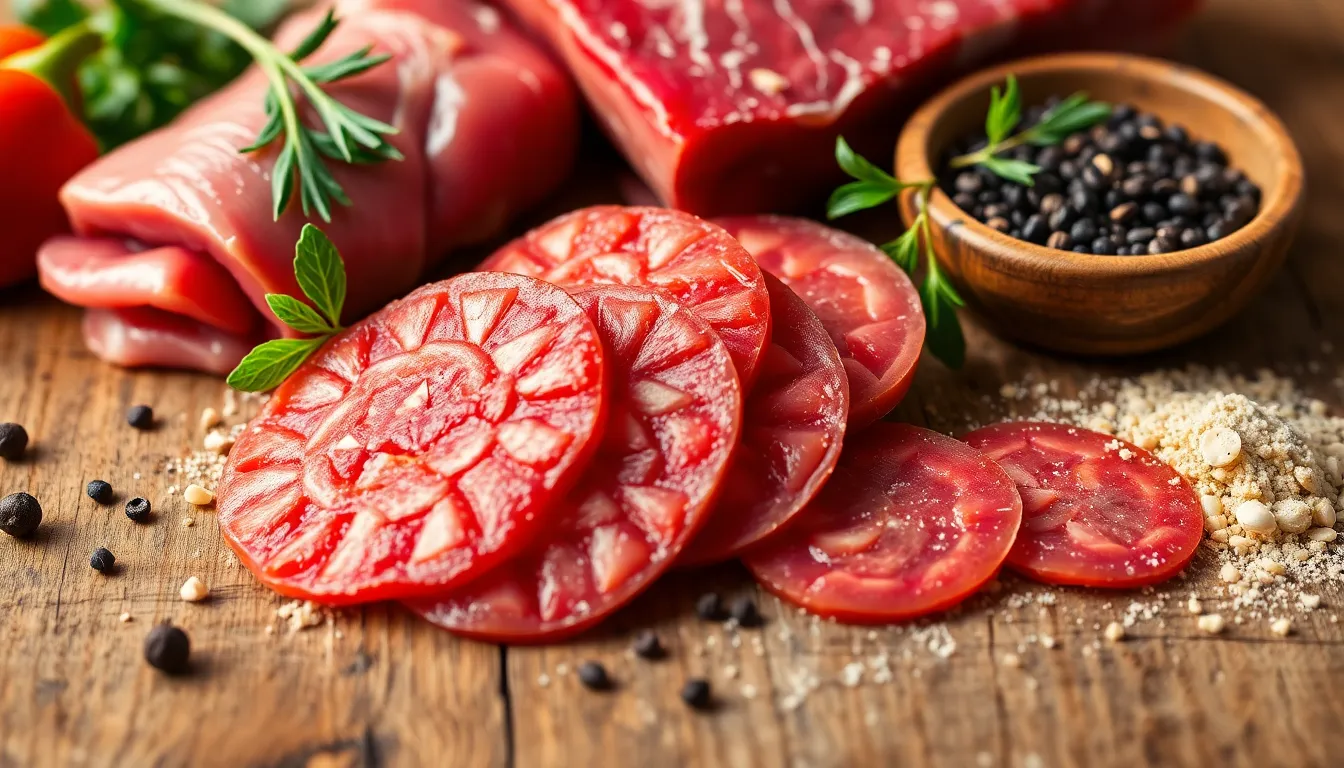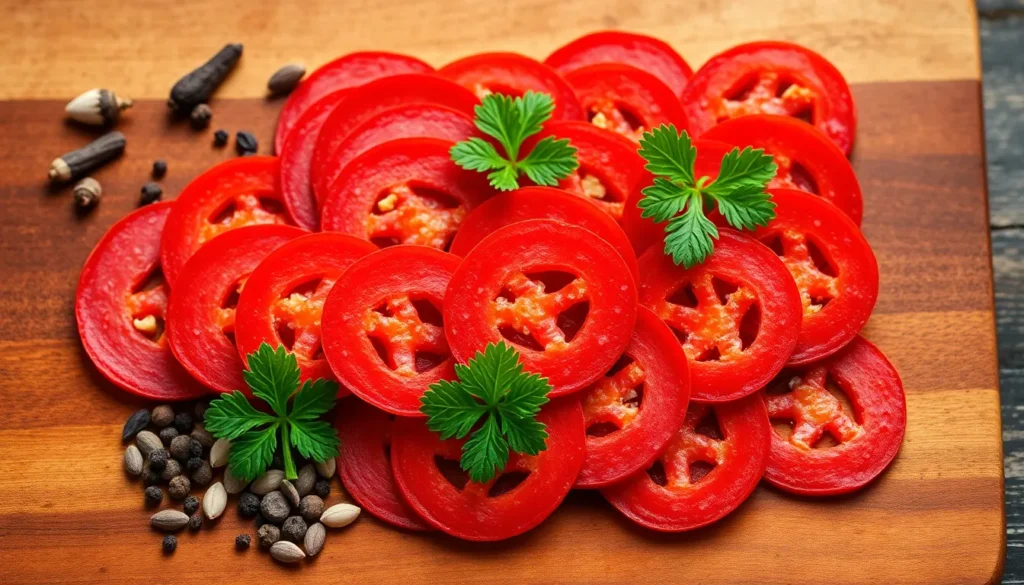Table of Contents
TogglePepperoni is a beloved topping that adds a savory kick to pizzas and sandwiches. But what exactly goes into this popular delicacy? Many people enjoy its rich flavor without considering the ingredients that create this iconic sausage.
Typically, pepperoni is made from a blend of pork and beef, seasoned with a mix of spices that give it that distinctive taste. The curing process not only enhances its flavor but also contributes to its vibrant red color. Understanding what pepperoni is made out of can deepen one’s appreciation for this culinary favorite and shed light on the choices behind food production.
What Is Pepperoni Made Out Of
Pepperoni consists primarily of a blend of pork and beef. It typically includes 50% pork and 50% beef, although variations may exist. The meat mixture is finely ground for texture.
Seasoning plays a crucial role in achieving pepperoni’s distinct flavor. Common spices include:
- Paprika: Adds color and a mild smokiness.
- Black pepper: Provides a spicy bite.
- Garlic powder: Contributes depth and warmth.
- Fennel seeds: Imparts an aromatic sweetness.
After mixing, the meat is stuffed into casings and then undergoes a curing process. This curing, usually involving sodium nitrite, helps preserve the meat and enhances its vibrant red color. The process also develops flavor through fermentation, typically lasting several weeks.
Once cured, pepperoni is often smoke-dried to intensify its flavor. The final product is sliced thin for easy use as a topping on pizzas, sandwiches, and other dishes. Understanding these ingredients and processes enriches appreciation for pepperoni as a flavorful delicacy.
Ingredients Used in Pepperoni

Pepperoni consists of a specific blend of meats and a variety of spices that contribute to its distinct flavor profile.
Meat Types
Pepperoni is primarily composed of two meats. Pork accounts for approximately 50%, while beef makes up the other 50%. This combination creates a rich, savory taste that’s essential to pepperoni’s appeal. Quality control during meat selection plays a crucial role in the final product’s flavor and texture.
Spices and Seasonings
Several key spices and seasonings enhance pepperoni’s taste. Common spices include:
- Paprika: Provides a mild sweetness and vibrant red color.
- Black Pepper: Adds heat and depth to the flavor.
- Garlic Powder: Infuses a robust aroma and taste.
- Fennel Seeds: Offers a slightly sweet, licorice-like flavor.
These spices are blended with the meat mixture before it undergoes curing, which further develops the flavors through fermentation.
Production Process
The production process of pepperoni involves several key steps that transform raw ingredients into the flavorful topping loved by many. Understanding this process reveals the care and craftsmanship involved in creating pepperoni.
Curing Process
The curing process begins with the preparation of the meat mixture, typically composed of 50% pork and 50% beef. After mixing the finely ground meats with a precise blend of spices and sodium nitrite, the mixture is stuffed into casings. Curing lasts several weeks, during which beneficial bacteria ferment the mixture. This fermentation not only preserves the meat but also develops the distinctive flavor and enhances the vibrant red color of pepperoni. Quality control during this phase ensures that the desired taste and texture are achieved consistently.
Smoking Process
Once curing is complete, the pepperoni undergoes a smoking process. This step typically involves exposing the cured sausage to wood smoke, which adds depth and complexity to its flavor. The smoking process also aids in drying the pepperoni, reducing moisture content and extending shelf life. After smoking, the product is sliced thin for convenient use as a topping on pizzas or in sandwiches, making it ready for culinary enjoyment.
Nutritional Information
Pepperoni provides a rich flavor alongside notable nutritional content. A standard serving of pepperoni, approximately 15 grams, typically contains:
| Nutrient | Amount per Serving | Daily Value (%) |
|---|---|---|
| Calories | 70 | 4% |
| Total Fat | 6 grams | 10% |
| Saturated Fat | 2.5 grams | 13% |
| Cholesterol | 20 mg | 7% |
| Sodium | 250 mg | 11% |
| Total Carbohydrates | 1 gram | 0% |
| Protein | 3 grams | 6% |
Pepperoni’s calorie content primarily results from fats, contributing to its savory taste. High sodium levels stem from the curing process, which aids preservation and flavor enhancement.
Pepperoni also contains vitamins and minerals, including:
- Vitamin B12: Promotes nerve health and energy metabolism.
- Zinc: Supports immune function and wound healing.
- Iron: Essential for oxygen transport in the blood.
While pepperoni offers protein and essential nutrients, moderation is important due to its high fat and sodium content. Understanding the nutritional profile assists consumers in making informed dietary choices while enjoying this popular topping.
Pepperoni remains a favorite topping for many due to its unique flavor and versatility. Its careful blend of pork and beef combined with a mix of spices creates a taste that’s hard to resist. The curing and smoking processes not only preserve the meat but also enhance its richness, making it a staple in various dishes.
While pepperoni offers some nutritional benefits like protein and essential vitamins, moderation is key due to its fat and sodium content. Understanding what goes into this beloved delicacy allows consumers to appreciate it even more. Whether on a pizza or in a sandwich, pepperoni continues to be a delicious choice for food lovers everywhere.





